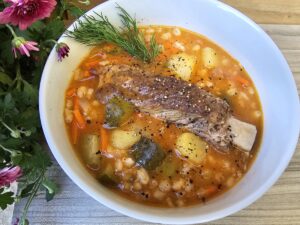When most people hear “ramen,” they often think of rich, heavy bowls like tonkotsu ramen —
the famous pork bone broth that’s thick, creamy, and full of emulsified fat.
Others may imagine tsukemen ramen, where cold noodles are dipped into a highly concentrated broth served separately.
But the truth is, everyday ramen in Japan looks very different.
Our Food400 ramen recipe is built around the style that’s eaten most often across Japan —
a chintan ramen (clear soup ramen), made with a clear, deeply flavorful broth that is clean, balanced, and layered without heaviness.
It is served hot with the noodles and broth together, not separated like tsukemen,
and it avoids the heavy emulsification of a tonkotsu or tori paitan ramen.
What Makes This Ramen Special
- Authentic to traditional Japanese ramen techniques — clear broth (chintan), separate tare seasoning, aromatic oils, and toppings layered with care.
- Highly customizable — each bowl can be made lighter or stronger depending on personal preference.
- Streamlined but deeply flavored — no unnecessary shortcuts, but designed for realistic home cooking without sacrificing flavor or authenticity.
- Inspired by Hokkaido ramen traditions — with optional miso tare, miso butter, and sweet corn toppings, famously associated with Hokkaido miso ramen from Sapporo.
- Family-friendly — everyone at the table can customize their perfect bowl of ramen easily.
A Touch of Hokkaido
Personally, I love Hokkaido — the cold winters, the comforting food traditions, the balance between richness and clean flavors.
While this recipe builds a classic clear broth ramen base (chintan), we have included optional elements inspired by Hokkaido miso ramen,
such as spicy miso tare and the famous butter and corn topping found throughout Sapporo’s ramen shops.
These additions allow you to bring a touch of that cozy northern Japanese tradition into your own kitchen.
Customization Is Everything
One of the most powerful features of this ramen system is how flexible and diner-friendly it is:
- I personally prefer a light broth with just a bare hint of tare seasoning.
- My husband and kids prefer a richer, deeply seasoned broth with extra tare stirred in.
- This system allows each person to be the boss of their bowl — adjusting seasoning, toppings, and richness to their liking.
It is not a one-size-fits-all experience. It is a true Japanese ramen shop experience at home.
Why This Recipe Stands Apart
- True to its roots: This ramen follows the proper structure of Japanese ramen preparation — separate broth, tare, oil, and toppings — unlike many Westernized shortcut recipes.
- Complex in flavor: By carefully layering broths, aromatics, and condiments, it captures the authentic depth and character found in real ramen-ya across Japan.
- Streamlined for real kitchens: It avoids overly complicated restaurant techniques that are impractical for home cooks, yet sacrifices nothing in flavor.
Most importantly, this recipe respects ramen as both a serious craft and a comforting, highly personal meal —
something you can adapt and enjoy again and again.
In Short
This Food400 ramen recipe is a clear broth ramen (chintan ramen) with authentic Japanese structure,
Hokkaido-inspired miso options, and full customization flexibility —
designed to deliver real ramen shop flavor at home without compromise.
Whether you crave a light, delicate broth or a rich, miso-butter corn-topped bowl,
this recipe gives you the tools to create your perfect ramen every single time.
Ramen
4-6
servingsIngredients
- For the Broth:
Use per bowl: 1–1 1/2 cups Option A.
1.2–1.5 kg chicken wings, backs, or necks
Optional upgrade: A few pork neck bones or chicken feet for added gelatin-rich body (great if freezing portions)
1 small onion, halved
1 small leek (white part only), split lengthwise
2 spring onion stalks
4 garlic cloves, smashed
2-inch knob of ginger, sliced thick
2 dried shiitake mushrooms (optional but recommended)
3 inch piece of carrot, optional and remove after 1.5 hours
1 small sheet kombu (~5x5 inches)
8 cups filtered water
Optional: 1 dried red chili or a few Sichuan peppercorns (adds subtle warmth)Option B.
Mushroom Ramen Broth (Umami-Rich, Fat-Light, No Bones Needed)
15g dried shiitake mushrooms (~5–6 large pieces)
1 small sheet kombu (~5 × 5 cm)
1 small onion, halved (or 1 small leek, cleaned and chopped)
1 small leek (white part only), split lengthwise
3 inch piece of carrot, optional and removed after 30 minutes
2 garlic cloves, smashed
1 thumb-sized piece of ginger, sliced
2 scallions (whole, tied in a knot or just cut into large pieces)
1 dried chili (optional, for subtle warmth)
1 cob of corn (optional, snapped in half, adds natural sweetness)
1 tbsp light soy sauce (early background seasoning), optional
1 tsp sugar or 1 tbsp mirin (rounds sharpness)
6 cups filtered water- Tare (Seasoning Base) - Two Options:
Use per bowl: 1–1¼ tbsp A. Soy-Garlic Tare (for 4–6 bowls, small batch)
Ingredients:
1/3 cup light soy sauce
2 tbsp mirin
1 tsp sugar
2 garlic cloves, grated
1 tsp grated ginger
1 tsp toasted sesame oil (optional)B. Spicy Miso-Chili Tare (Fried Miso Style, for 4–6 bowls)
Ingredients:
2½ tbsp red miso (or awase/mixed miso)
1 tbsp soy sauce
1 tbsp mirin
1 tsp Doubanjiang (or other chili paste)
1 garlic clove, grated
½ tbsp toasted sesame oil
1 tbsp neutral oil (for frying miso)- Aromatic Oils (Finishing Touch):
Use per Bowl:
½–1 tsp aromatic oil drizzled over the noodles and broth. A. Garlic-Scallion-Ginger Oil (Updated)
Ingredients:
2 stalks green onion, finely minced
2 garlic cloves, minced
½ inch ginger, finely grated
2–2.5 tbsp neutral oil
Pinch of saltB. Spicy Chili-Sesame Oil
Ingredients:
2 tbsp neutral oil
½ tsp chili flakes
½ tsp toasted sesame oil- Toppings:
Toppings (Choose a few)
Soft-Boiled Egg: Boil for 6½ minutes, chill in ice water. Optional: marinate in 1:1 soy sauce + mirin for a few hours.
Blanched Greens: Spinach, bok choy, or choy sum.
Corn Kernels: Sautéed briefly in butter for sweetness.
Tofu Cubes (Updated): Cut into ½ to ¾ inch cubes. Too-thin tofu crisps too much. Bake at 400°F for 20–22 minutes, flipping once. Optional broil 1–2 min.
Seared Shiitake Mushrooms: Sear 2–3 min per side in neutral oil until golden.
Radish Flowers / Scallions / Seaweed: Add visual contrast and brightness.
Nori: thinly sliced- For Noodles:
Alkaline straight ramen noodles (~100–120g per person), 4-6 bundles
- Optional Flavor Bomb:
1 tsp butter mixed with ½ tsp miso paste, dropped on top (melts slowly into the soup).
Directions
- For the Broth:
- Option A:
Blanch chicken in boiling water 2–3 minutes. Drain and rinse.
In a large stockpot, add chicken, onion, leek, garlic, ginger, shiitake and 8 cups water.
Bring to a gentle boil, then immediately lower to a gentle simmer.
Partially cover the pot (leave 1–2 inches open) to reduce slowly without losing too much water.
Simmer for 2½ to 3 hours.
At the 2-hour mark, add kombu (DO NOT boil after adding).
After 15–20 minutes, remove kombu.
Strain broth. Skim excess fat if desired (for a cleaner flavor).
Broth Yield Goal: End up with ~6 cups of broth.
Option B:
Soak dried shiitakes in 2 cups warm water for 30 minutes.
Strain soaking liquid through a fine mesh sieve and reserve it.
In a large pot, add:
Soaked, sliced shiitake mushrooms
Reserved soaking liquid
Onion (or leek)
Garlic
Ginger
Scallions
Corn cob (optional but excellent)
Dried chili
Soy sauce
Sugar or mirin
Remaining 4 cups filtered water
Bring to a very gentle simmer (not a boil!) and simmer uncovered for 45–60 minutes.
Add kombu in the last 15–20 minutes of cooking. Don't let it boil.
Strain the broth through a fine mesh sieve. - For Tare:
- Option A:
Combine everything in a small saucepan.
Simmer gently for 2–3 minutes to mellow the garlic and dissolve sugar.
Cool and store airtight.
Option B:
In a small pan, sauté the miso in neutral oil over medium-low heat until fragrant (~1 min). Be careful, watch closely, it can burn fast!
Add garlic and Doubanjiang, stir for 30 seconds.
Stir in soy sauce, mirin, and sesame oil.
Warm through gently and store airtight. - For Aromatic Oil:
- Option A:
Heat oil in a small saucepan until shimmering.
Pour hot oil over green onion, garlic, and ginger in a heatproof bowl.
Stir and let sit for 5–10 minutes.
Option B:
Warm oil gently with chili flakes.
Turn off heat once fragrant. Stir in sesame oil.
Let cool. - Toppings (Choose a few)
Soft-Boiled Egg: Boil for 6½ minutes, chill in ice water. Optional: marinate in 1:1 soy sauce + mirin for a few hours.
Blanched Greens: Spinach, bok choy, or choy sum (usually for under a minute depending on the greens of choice.)
Corn Kernels: Sautéed briefly in butter for sweetness.
Tofu Cubes (Updated): Cut into ½ to ¾ inch cubes. Too-thin tofu crisps too much. Bake at 400°F for 20–22 minutes, flipping once. Optional broil 1–2 min.
Seared Shiitake Mushrooms: Sear 2–3 min per side in neutral oil until golden.
Radish Flowers / Scallions / Seaweed: Add visual contrast and brightness.
Nori: thinly sliced
Various Seared Proteins - For the Noodles:
- Boil only when bowls are nearly assembled.
Dry alkaline noodles cook fast: usually 2–2.5 minutes. Test early.
Do not rinse. Drain and immediately add to bowls.
Optionally: Dip briefly in hot broth to coat before serving. - Optional Flavor Bomb:
- 1 tsp butter mixed with ½ tsp miso paste, dropped on top (melts slowly into the soup).
- Final Assembly (Per Bowl)
- Tare 1 to 1¼ tbsp
Broth 1½ cups
Noodles 1 bundle (100–120g)
Aromatic Oil ½–1 tsp
Toppings: Egg, corn, tofu, mushrooms, radish, greens, nori
Tip: Assemble quickly so noodles stay springy. Place toppings with intention. Drizzle oil last. Butter miso pat is optional and amazing.
Add the Optional Flavor Bomb: 1 tsp butter mixed with ½ tsp miso paste, dropped on top (melts slowly into the soup).
Notes
- Fully refined, Hokkaido-inspired miso ramen system that respects technique but fits home kitchens. Not too fatty, not too light. Perfectly layered. Your ramen = restaurant-level comfort food.
- Pro Ramen Noodle Tip (Condensed)
After boiling and draining ramen noodles:
Briefly dip them into your finished hot broth (1–2 seconds) before placing into the serving bowl.
Why?
Pre-coats the noodles with broth for better flavor absorption.
Keeps noodles hotter.
Prevents noodles from clumping or cooling before broth hits them.
Science:
Noodles carry surface starch after boiling.
Dipping quickly washes the starch, slicks the surface, and helps broth cling evenly to the noodles.
How:
Boil and drain noodles as normal.
Dip into the same hot chicken broth you will be serving (no second pot needed).
Lift out, place into tare-prepared bowl, and assemble toppings.
Pour hot broth over and serve immediately.
Result:
Hotter, silkier, more professional ramen with better broth-to-noodle connection. - Mushroom Broth Extra Tip (Optional):
If you want even deeper mushroom umami, adding a few dried porcini with the shiitakes would push it over the top! - Chicken Broth Minor Note:
If you add pork bones or chicken feet, you should expect a slightly thicker broth (but it’s still clean compared to tonkotsu).











